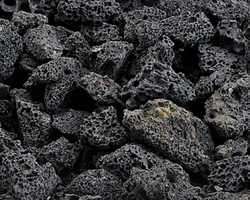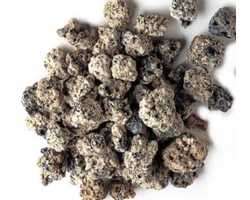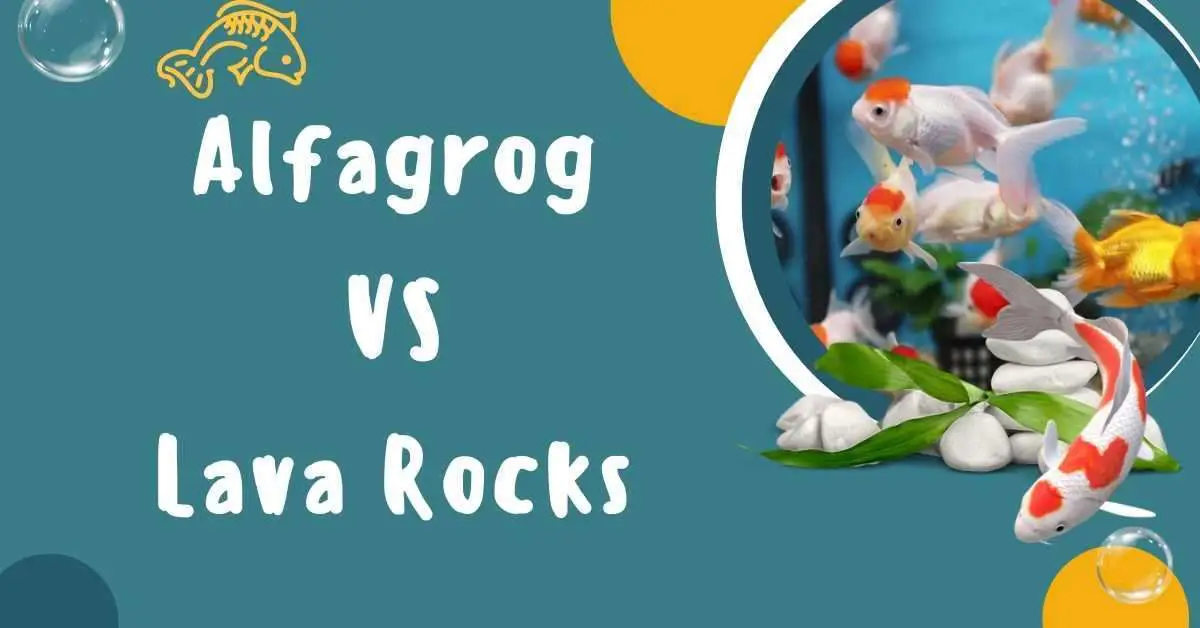Many different substrates can be used for fish tanks, and it depends on what type of fish you have in the aquarium. Some people prefer to use gravel, while others like sand or even rocks. There is also a variety of different colors and sizes of substrate that you can choose from, so you can customize the look of your fish tank. Ultimately, it is up to you to decide which substrate you want to use for your fish tank. So you should experiment to see which one works best for you and your fish.
Lava Rock Overview

Lava rock is a type of igneous rock that forms when molten lava cools and solidifies. It is often used as an ornamental stone in aquariums. It is typically red, black, or brown and has a rough, porous surface. It can also be used to make jewelry, sculptures, and other decorative items.
Lava rock is a popular material used in fish tanks for both aesthetic and functional purposes. Lava rock has a porous surface that can provide ample surface area for beneficial bacteria to colonize. This can help to filter the water in your fish tank and create a natural healthy environment for your fish.
Lava rock can also be used to create caves and hiding places for your fish. Additionally, lava rock can help to buffer pH levels and provide essential minerals for your fish. Lava rock is also very porous, which means it can help to aerate the water in your tank and keep it oxygenated.
If you are considering using lava rock in your aquarium, make sure to rinse it thoroughly before adding it to the tank. You may also want to soak it in dechlorinated water for 24 hours before use. This will help remove any dust or debris from the surface of the rocks.
Generally, lava rock is not commonly used in fish tanks because it is very dense and can easily break glass aquariums. In addition, the sharp edges of lava rock can injure fish and other aquatic creatures. If you do use lava rock in your fish tank, be sure to smooth out any sharp edges with a file or sandpaper before adding it to the tank.
Benefits of Lava Rock
Lava rock not only looks good, but it also has many benefits for your fish tank:
• Lava rock makes a great visual backdrop in an aquarium setting.
• The unique texture and color of lava rocks can make your fish tank stand out, and they can be used to create all sorts of interesting aquascapes.
• Lava rock provides space for shrimp to forage food that may fall into the holes of the rock surface; Shrimp also prefer to hide in a safe place in the holes of the rock surface during molting;
• Lava rock is porous, so it can help to filter your water and keep it clean.
• Lava rock is very affordable and easy to find.
• It can help to create a more eye-catching and natural-looking environment for your fish.
• The porous nature of lava rock makes an ideal space for promoting beneficial bacterial growth in your aquarium. These bacteria play an important role in the aquarium ecosystem by breaking down waste products and helping to keep water conditions balanced.
• It can help maintain pH levels in the aquarium water within a desirable range.
A Disadvantage of Lava Rock
Lava rock is a popular choice for fish tanks because it is attractive, lightweight with a porous surface, and easy to find. However, there are some disadvantages to using lava rock in fish tanks:
• The porous surface of lava rock can harbor bacteria and other organisms that may be harmful to fish and other creatures.
• The sharp edges of the rocks can injure fish if they collide with them or if they bump into them or try to swim through them. It can also damage their fins and tails.
• Lava rock has a porous surface. This means that bacteria and other organisms can grow inside the pores of the rocks. If these organisms get into your fish’s water, they could make your fish sick or even kill them.
• The buffering capacity of lava rock help to prevent drastic changes in pH levels which could be harmful to your fish or other aquatic creatures living in the tank.
• Naturally, various types of minerals such as iron and magnesium, etc. are present in lava rock that may influence the pH level in your aquarium water, making it harder. In this case, it is tough to treat algal bloom due to hard level pH water.
• Finally, lava rocks are not very dense, so they may float or shift around in the tank, which can create problems with water quality and filtration.
Some Frequently Asked Questions
How To Clean, Prepare Lava Rocks For Aquarium Use?
Lava rocks are a popular choice for aquariums because of their unique appearance. But before you add them to your tank, you will need to clean and prepare them first. Here is how:
- Firstly, you place the rock in a bucket;
- Add water to the bucket and rinse the lava rocks to remove any dirt or debris; In this case, scrub the rock with a stiff brush to remove any dirt or debris on the surface and crevices.
- Soak the rocks in a solution of 1 part bleach to 10 parts water for 30 minutes. This will kill any bacteria or parasites that may be on the surface of the rock. Make sure you rinse the rocks thoroughly with clean water after this step;
- After soaking, rinse the rocks again with fresh water;
- Boil the lava rocks for 20 minutes to sterilize them completely;
- Allow the lava rocks to dry completely before adding them to your aquarium;
Can You Use Lava Rocks as Aquarium Substrate?
Lava rock is a type of igneous rock and it is a popular choice for use as an aquarium substrate because of its porous nature, which allows them to hold onto water and nutrients well. Besides, their rough surface provides a good place for beneficial bacteria to colonize, helping to keep your tank clean.
One thing to keep in mind if you are considering using lava rocks in your aquarium is that they can be quite sharp as a result, they may not be suitable for all types of fish. Be sure to smooth out any edges with sandpaper before adding them to your tank so that it does not accidentally injure your fish or other aquatic creatures. Be sure to do your research and consult with professional aquarists before making a decision.
Can You Use Lava Rocks For Aquarium Filter?
Lava rocks are a popular choice for aquarium filters because they are highly porous and absorb lots of water making them ideal for filtering large amounts of water. They are also very affordable and easy to find. This makes them great at trapping debris and waste, which keeps your tank clean. Lava rocks also last a long time, so you won’t need to replace them as often as other types of filter media.
Lava rock is suitable for keeping space for beneficial bacteria due to its porous surface. These bacteria make the aquarium environment healthy by breaking down excess nitrates and finally they remove it from the aquarium water. Bacteria from the surface of lava rock produce oxygen and nitrogen by consuming nitrates and removing them from the tank water.
Alfagrog Overview

Alfagrog is a clay-based product that can be used in fish tanks to provide a variety of benefits for your fish.
Alfagrog can help to create a more natural environment for your fish, and it can also help to filtrate and clean the water in your tank. It can also provide a place for beneficial bacteria to grow.
Alfagrog is a great addition to any fish tank because it provides a place for the fish to hide and feel safe.
Alfagrog can also help to filter out toxins from the water, making it healthier for the fish.
Benefits of Alfagrog
• It has a tremendously high surface area;
• It is extremely porous;
• It is lightweight;
• It is inexpensive to purchase;
• It is easy to find;
• It can help to create a more natural environment for your fish,
• It can also help to filtrate and clean the water in your tank;
• Alfagrog can also provide a place for beneficial bacteria to grow;
• It provides a place for the fish to hide and feel safe;
• Alfagrog can also help to filter out toxins from the water;
• Alfagrog can also be used to create different shapes and designs in the aquarium.
• It is often used in conjunction with other materials, such as gravel or sand;
• It helps improve water quality and clarity in your aquarium;
• It is also effective at absorbing toxins and helping to control algae growth;
• This product can help provide better filtration and aeration for your fish tank;
• It won’t add any unwanted chemicals or pollutants to your aquarium;
A Disadvantage of Alfagrog
Alfagrog can be beneficial for some fish, but there are also some disadvantages to using it.
• It can be harmful to small or delicate fish if they ingest it.
• It can make the water cloudy if not used properly.
• It is not very durable because if your fish are particularly active or like to dig, they can easily damage the alfagrog and cause it to break down.
• Over time, the alfagrog will start to disintegrate and release particles into the water. This can be harmful to your fish and cause water quality issues.
• Alfagrog is quite porous and can absorb toxins from the water, which can be released back into the aquarium over time. If you do use alfagrog in your tank, be sure to monitor the water quality closely and perform regular maintenance.
What Are the Differences Between Lava Rock and Alfagrog?
Aquarium hobbyists often debate over which is better – alfagrog or lava rock. There are pros and cons to each type of substrate, so it comes down to personal preference so it is important to do some research before making a decision. Here’s a rundown of the differences between these two popular options:
Alfagrog is made from fired clay, which makes it very dense and heavy. This can be good or bad, depending on your needs. The weight helps to keep plants in place, but it can also make the aquarium difficult to move if you need to do so.
Some hobbyists like alfagrog because it provides a natural filtration system for the tank; others don’t like the idea of their fish swimming around in water that has been filtered through another animal’s waste products.
Lava rock is much lighter than alfagrog, making it easier to move around if necessary.
Lava rock is also more uniform in shape and size than alfagrog, which some people prefer aesthetically. However, because lava rock is less dense than alfagrog, plants may not root as well in this substrate (though this isn’t always the case).
Alfagrog is inexpensive and easy to find while lava rock can be expensive and difficult to find in some areas.
Alfagrog has a neutral pH level, which is ideal for most fish tanks while lava rock has a high pH level, which means it is not suitable for all fish tanks.
Alfagrog can be difficult to clean and can harbor bacteria while lava rock is easy to clean;
You might also read: API Fungus Cure Review
Alfagrog and Lava Rock: Which Is Better for Fish Tank?
Alfagrog and Lava Rock are two popular options for fish tanks. So, which one should you use? Let’s take a closer look at each option to help you decide.
Alfagrog is made from fired clay and is a popular choice for many aquariums. It is very porous, so it can help to keep the water in your tank clean and aerated. Additionally, Alfagrog can be used to create caves and other hiding places for your fish.
Lava Rock is another popular option for fish tanks. It is lightweight and has a lot of surface area, which can help to keep the water in your tank clean and aerated. Additionally, Lava Rock can be used to create caves and other hiding places for your fish.
Both have their pros and cons, so it is important to do some research before making a decision. Here’s a quick rundown of each option:
Alfagrog
• It can help keep your water clean and clear by absorbing waste and debris.
• It is cheaper than other substrates on the market.
• It can be difficult to find in stores.
• It may not last as long as other substrates before needing to be replaced.
Lava Rock
• It is very porous, which can help with filtration and aeration in your tank.
• It looks natural and can provide a nice aesthetic for your fish tank setup.
Concluding Remarks
Lava rock is a good choice if you want a substrate that will help keep your tank clean. It is also very porous, so it provides a lot of surface area for beneficial bacteria to grow. However, lava rock can be difficult to keep in place, and it is not the best choice if you have plants in your tank.
Alfagrog is another popular substrate choice for fish tanks. It is made from fired clay, so it has many of the same benefits as lava rock (including being very porous and providing a lot of surface area for beneficial bacteria). However, alfagrog is much easier to keep in place than lava rock, making it a better choice if you have plants in your tank.

